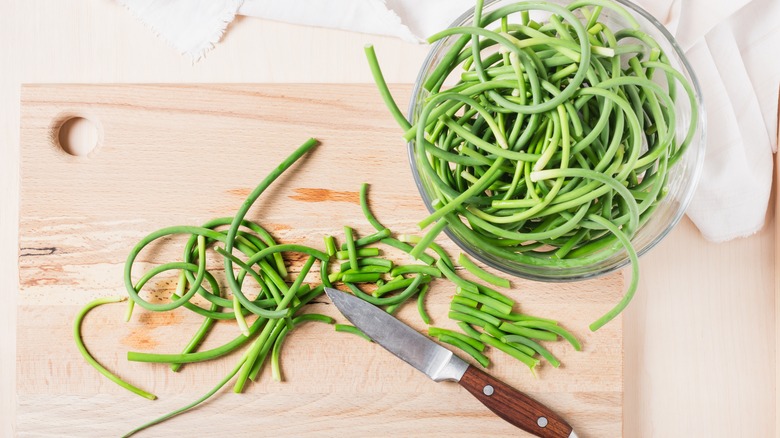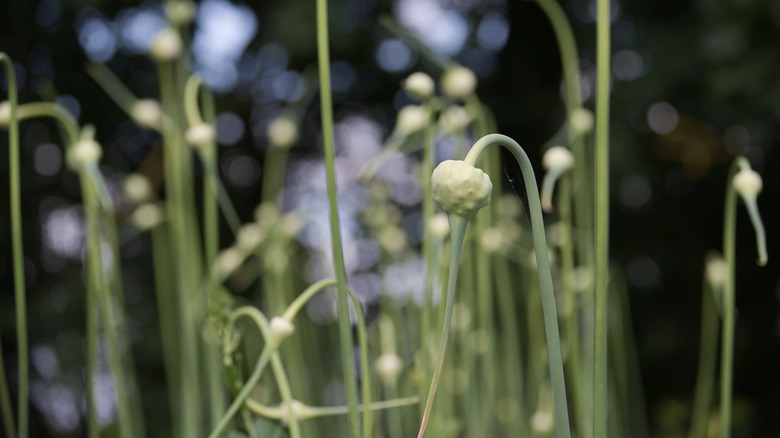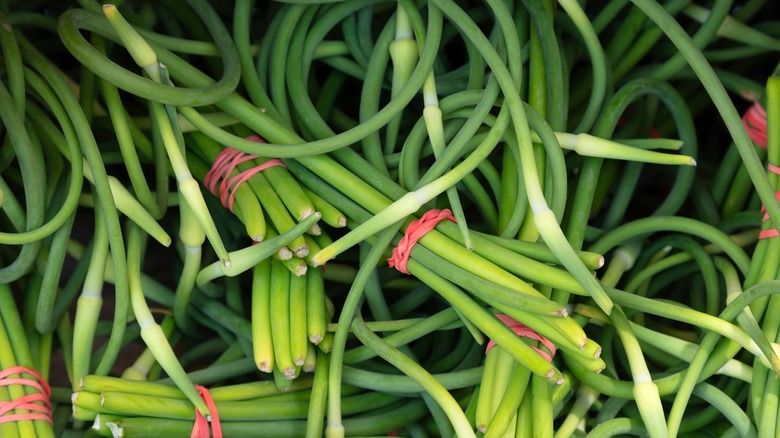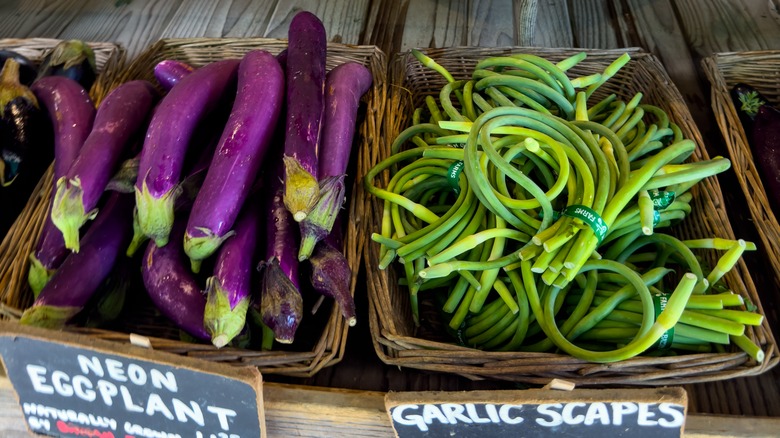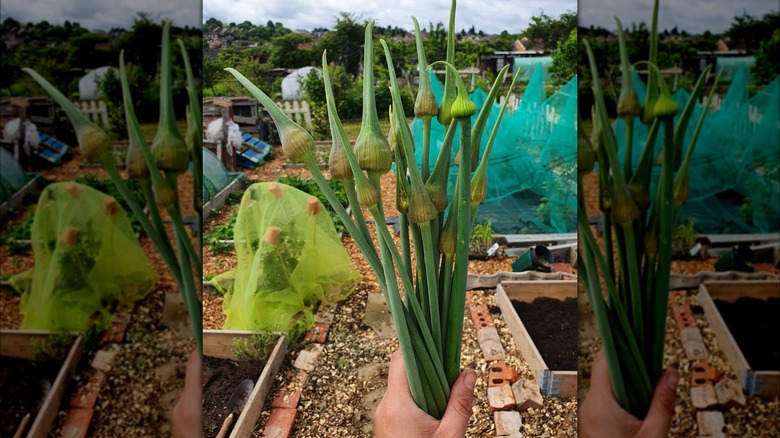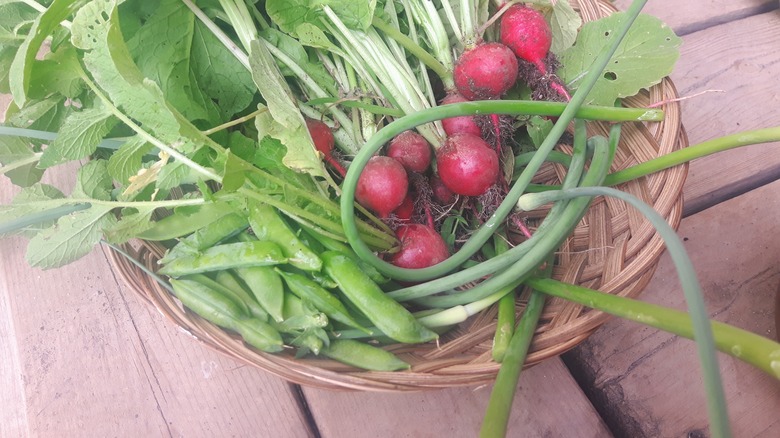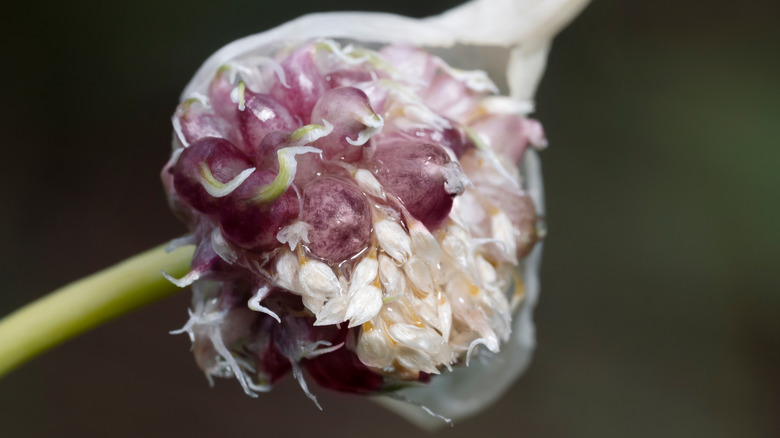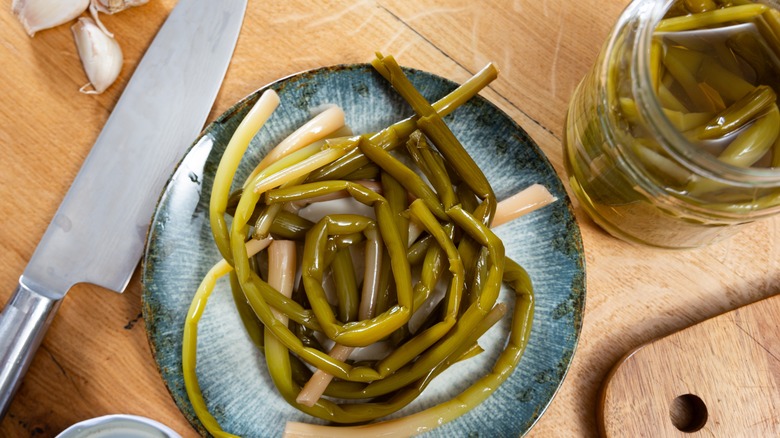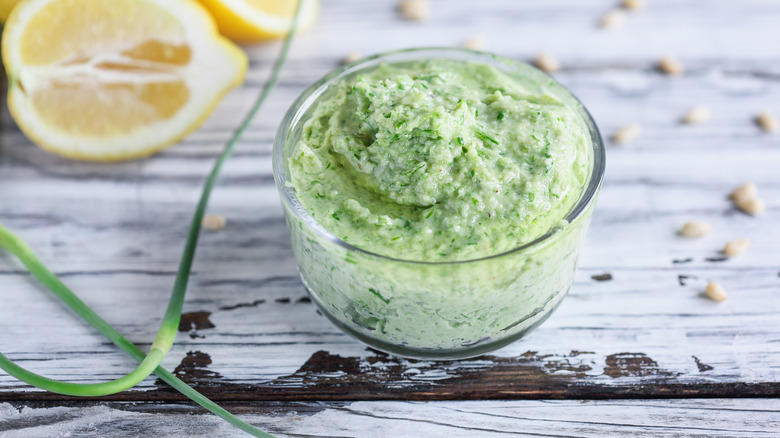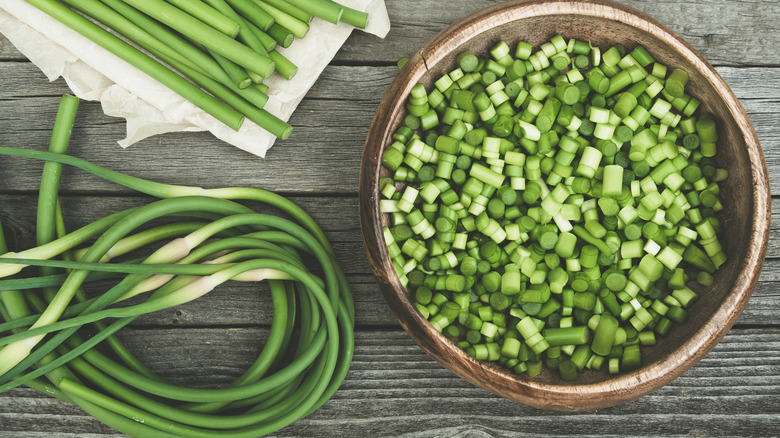What Are Garlic Scapes And How Do You Cook With Them?
We may receive a commission on purchases made from links.
If you love heading to the farmers' market and basing some of the week's menu on what you find there, you're certainly not alone. But even among all the variety and bounty of fresh produce, it's easy to fall into a rut, or simply pass by fruits and vegetables that might be a little unfamiliar. That means plenty of hidden gems can be overlooked at your local farmers' market, including garlic scapes.
These blooming stalks grow from bulbs of garlic, making the plant one of many that bear edible flowers. Garlic as a whole is pretty amazing, considering that every part of it is edible, in both its raw and cooked form. And scapes? They are flavorful and nutritious. They're also so versatile that once you start using them, you might find yourself growing your own garlic just to always have some on hand.
Garlic can be grown indoors in containers, so the process is simple for even novice gardeners. There are a variety of bulbs available for order on Amazon, from fresh Siberian hardneck bulbs to gourmet Chesnok red garlic. The key to making the most of your growing project is to really understand garlic scapes in the first place.
What, exactly, are garlic scapes?
First, let's start with exactly what garlic scapes are: They're the stem of what will become a garlic flower. You'll be able to tell the difference between the scapes and the leaves because the scape is much thicker, and it tends to curl or spiral as it grows up from the center of the plant. When scapes mature, they'll be taller than the leaves.
If you're growing garlic, scapes are also a good indicator of how far along the bulbs are in their development cycle. Scapes can also give you a general idea of when they're almost ready to be harvested. Depending on the variety, scapes are ready for harvesting between two and four weeks before the garlic bulb is mature and ready to be dug. (You'll know that it's time for that when about half of the garlic leaves have turned brown.) If scapes are not harvested, they'll turn into flowers and seeds that can be used to grow more garlic.
What do garlic scapes taste like?
Once they're harvested, garlic scapes look a lot like scallions. If you're browsing in the market or the produce section of your favorite grocery store, it's easy to get the two confused. You might think of the two types of greens as cousins. They're both part of the allium family, so they have similar uses in recipes, but they have different flavors and textures.
Garlic scapes have a heavier texture that isn't dissimilar to asparagus. But don't worry, when it comes to flavor, they're all garlic. If you can imagine a mild garlic that has a bit of onion and scallion thrown in for good measure, you're on the right track. When they're raw, they have a mild herbaceous quality, and just as garlic gets milder when it's cooked, the same thing happens to garlic scapes. Saute them into a stir fry, for example, and they'll add a fresh, sweet garlic flavor that will take a dish to the next level.
Where, when, and how can you find garlic scapes?
Garlic scapes are an ultra-seasonal delicacy, so when you find them, you should definitely pick some up. When they're in season, you can check grocery stores and farmers' markets, or try ordering them online. Check large-scale garlic growers, and there's a good chance you'll even be able to order scapes by the box. (And yes, we're also going to tell you how to preserve them for year-round enjoyment.) They're also commonly found in Asian supermarkets.
Exact times might vary depending on where you're located, but generally speaking, you can start looking for garlic scapes in the first part of June. Some areas might see them appear as early as April, though, so you might want to ask grocers in your area.
Each garlic bulb produces only a single scape, so when you're looking at a box of them, there's a lot of work that went into growing and harvesting them. To pick the very best ones, look for firm scapes that are bright, uniformly green, and have no bruising or holes (which can be a sign of insects). When it comes to size, smaller scapes are going to be more tender. You'll also want to look for scapes that have a distinct curl, as they are the younger stalks.
If you grow your own garlic, you should definitely remove the scapes
Let's say that you are growing your own garlic. Should you remove the scapes? Absolutely! With the scapes removed, your garlic bulbs will get up to 30% larger.
Fortunately, it's easy to do although there is some conflicting information on the best way to remove scapes. Chowhound reached out to Stacey Cooper, the director of agriculture at the Cedar Circle Farm & Education Center in Vermont. She told us that the best way to remove scapes is with a sharp knife or scissors. "A clean cut is the best practice," she explained. "A nice clean cut can heal quicker and is less likely to become an entry point for pests and disease."
So why the conflicting information? Cooper explained that when garlic and scapes are grown on a farm scale, it's faster to break them off by hand rather than cutting them with a tool. That sometimes gets recommended by default. Interestingly, although garlic scapes are becoming more well-known, large-scale farms like Cooper's still end up with extra. "We personally have way more scapes than we can process or sell, so there is only a market for a portion of them," she said. "Efficiency does matter, as it does on most farms." In other words: Start using those garlic scapes!
Garlic scapes pack a nutritional punch
Adding garlic scapes to the menu isn't just adding a lightly herbaceous garlic flavor, you're also adding some nutritional benefits, too. The nutritional profile of scapes is similar to that of garlic itself, and they include calcium, manganese, and vitamins A, C, and B6. Scapes are also rich in antioxidants, and they contain allicin, which is an antibiotic that some studies have linked to preventing infections caused by antibiotic-resistant bacteria.
Garlic — and by extension, garlic scapes — have other benefits, too. Studies have linked these flavorful foods to boosting the immune system, helping to manage cholesterol, contributing to a healthy cardiovascular system, improving bone health, protecting against certain types of cancers, and even helping to prevent liver damage.
Garlic is most effective when it's eaten raw, which makes garlic scapes and its mild flavor the perfect way to get nutritional benefits along with a taste that doesn't overpower whatever you're adding it to.
Growing more garlic from scapes is easy
Growing garlic is easy, but there are some things to keep in mind — starting with the fact that you shouldn't plant garlic you buy at the grocery store. There are a few reasons for that, including the fact that changes in climates and growing conditions will make it hard to get store-bought garlic to grow, and there's a likelihood of introducing diseases to your soil. You should only plant garlic that's specifically meant for planting. Fortunately, it's easy to order bulbs off Amazon, such as these early purple Italian garlic bulbs.
Here's where the garlic scapes come in. If you leave garlic scapes to grow and mature, they'll develop something called bulbils, which are like mini garlic cloves. One garlic scape can have as many as 50 bulbils and each bulbil can be planted to grow a whole new bulb of garlic. Not only is this a great way to grow garlic, but the resulting bulbs tend to be larger and healthier than cloves of garlic that are reproduced by planting mature cloves.
Stacey Cooper explained why this happens. "The larger and healthier the plant, the larger and more vigorous the bulbil," she said. In other words, you can start with healthy garlic bulbs, leave the garlic scapes on your largest plants, and have bulbils to re-plant for even more delicious garlic.
A variety of dishes can benefit from garlic scapes
As garlic scapes are suitable for use either raw or cooked, there are a wide variety of ways they can be added to dishes — and in some cases, they're the star. Stacey Cooper recommends one way to enjoy them. "Pickled scapes is [a] favorite," she said. "Think dilly bean, but with a garlic kick."
Cooper also suggests using them to make pesto, which you can then swap your oil out for and make some truly stellar fried eggs. They'll also add a whole new dimension to your favorite hummus, and you can even use them to create an incredible compound butter or fine-dice them and add them to a salad or a dressing.
Garlic scapes can also make an incredible side when simply roasted in the oven with some salt, pepper, and olive oil. They'll also work brilliantly in your favorite stir-fry recipe and in Asian-inspired dishes such as five-spice beef and broccoli. Try frying them with bacon, adding them to your favorite curry, or whipping up a delicious Thai-inspired coconut and pumpkin soup and topping it with slices at the end.
Can you use garlic scapes in place of green garlic or scallions?
Garlic scapes, green garlic, scallions ... at a glance, they can definitely be difficult to tell apart. But what, exactly, are the differences, and can you use them interchangeably?
While garlic scapes are the flower stem of the garlic bulb, green garlic is the entire immature plant. There are some differences. Green garlic tends to be milder and more tender than garlic scapes, but they can be substituted for each other with only minor differences in the end product. You can also use garlic scapes in place of scallions, as long as you keep in mind that they won't have the same level of sweetness.
There is a caveat to making substitutions, however, but it's an easy one to remember. Because the white and green sections of onions and garlic cook differently, you should only swap delicate greens for delicate greens. Use garlic scapes wherever you would use the green part of scallions or even chives, and you'll be golden.
Here's how to best store your garlic scapes
Although they are only available for a short time, it's easy to store garlic scapes so you can enjoy them year-round, and it only takes a little bit of prep. Keep fresh scapes in a bag or container in the fridge and they'll be fine for up to three weeks.
If you'd like to use them beyond three weeks, opt for dehydrating them. Just dice them and put them in your dehydrator for anywhere from four to six hours. Once they're dry, you can store them as they are or grind them into a powder.
Garlic scapes also freeze really well, and that's what Stacey Cooper does. "Since it is a busy time of year and I'm low on prep time, I love to just dice them very small (like scallions) and freeze them in bags," she said. "I break off a chunk any time I need garlic in a recipe all winter, and add a bit extra since they aren't quite as strong as garlic bulbs once frozen." Now that you know everything about these flavorful sprouts, you have every reason to make the most of this delicious, nutritious garlic plant!
